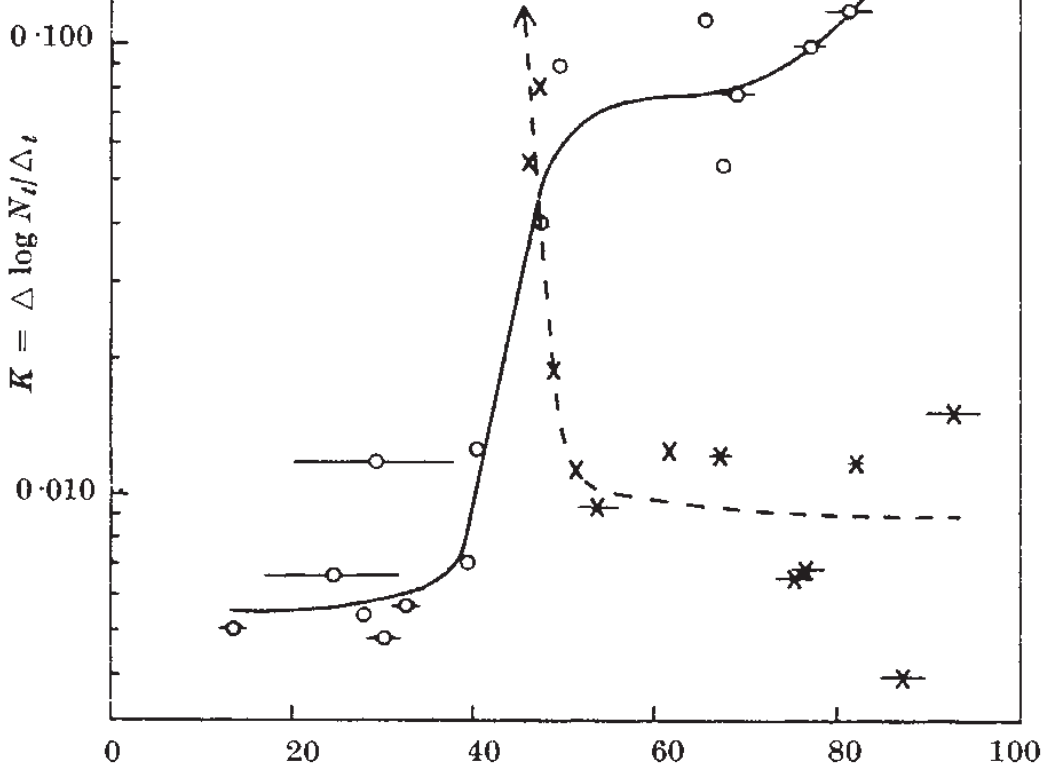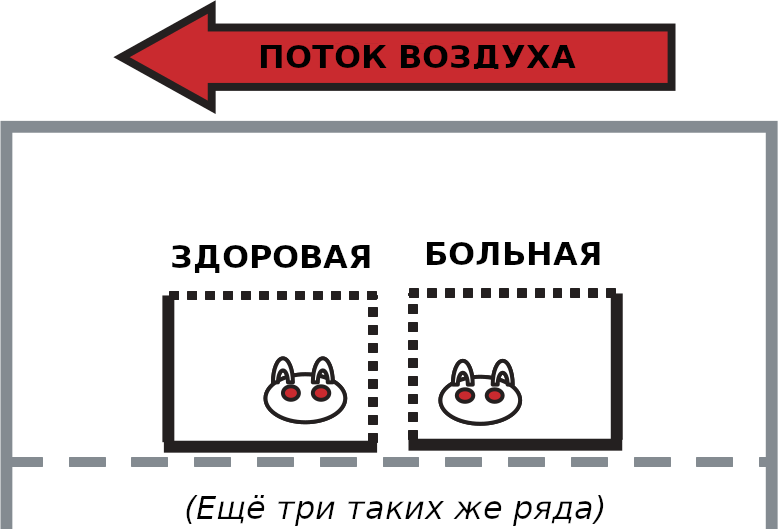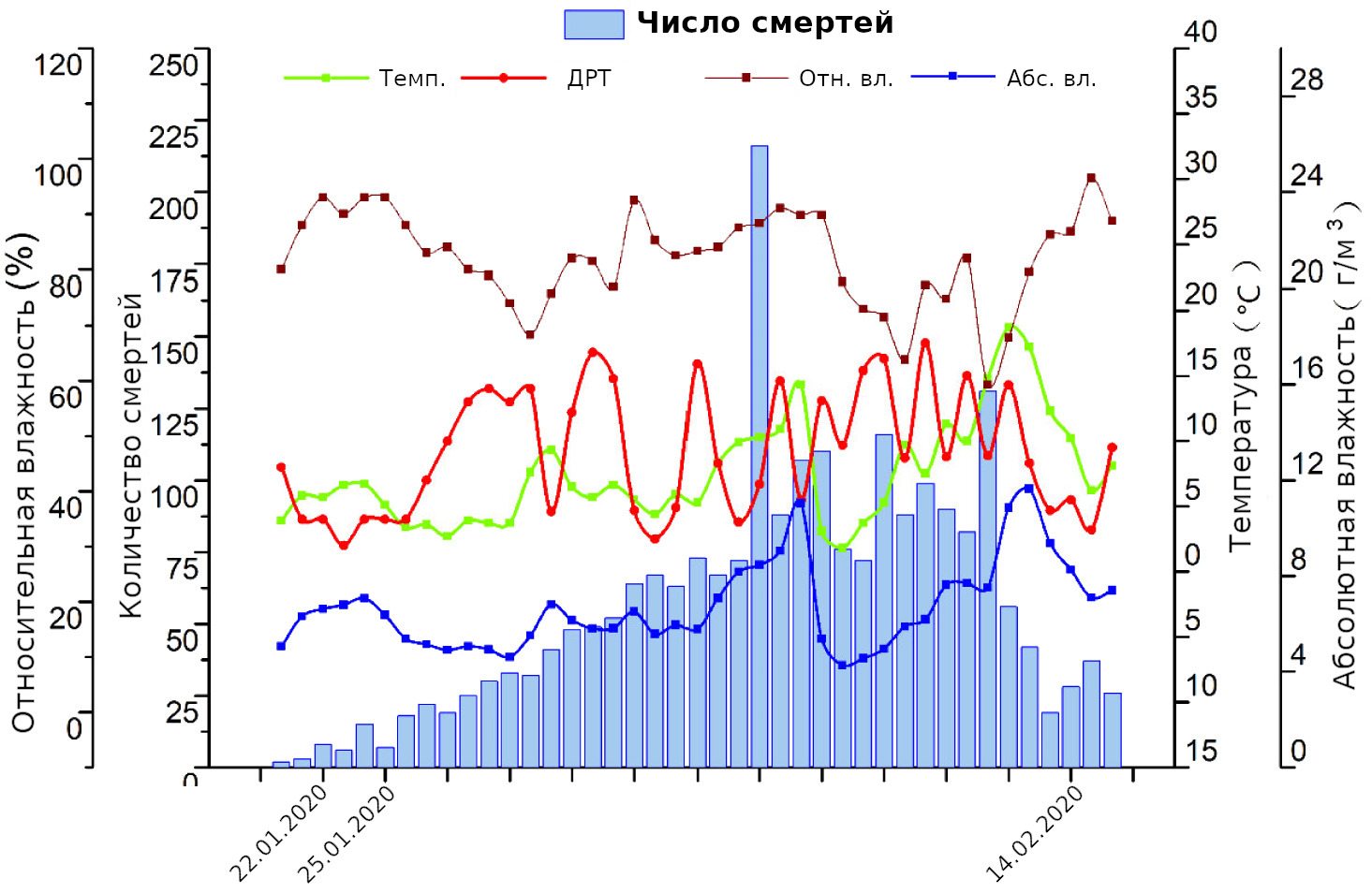Hemmes J. H. et al. Virusüberleben als saisonaler Faktor bei Influenza und Poliomyelitis, Nature 1960, 188: 430-431.
Experimente haben gezeigt, dass das Influenzavirus bei niedriger Luftfeuchtigkeit länger in der Luft und das Polio-Virus bei hoher Luftfeuchtigkeit länger anhält. Dies steht im Einklang mit der beobachteten Influenza-Aktivität im Winter und der Polio-Aktivität im Sommer. Die erste Grafik im Artikel zeigt die Inaktivierungsraten (Tod) von Influenza- (\ (\ circ \)) und Poliomyelitis- (\ (\ times \)) Viren auf einer logarithmischen Skala in Abhängigkeit von der relativen Luftfeuchtigkeit (in Prozent):

Harper G. J. Mikroorganismen in der Luft: Überlebenstests mit vier Viren, Epidemiology & Infection, 1961, 59 (4): 479-486.
, , . . , — . , 64% 24 °C, — 3–4%.
Akers T. G., et al. Airborne stability of simian virus 40 ( SV40 ), Applied microbiology, 1973, 26(2):146–148.
, SV40 ( ). 21 °C ( 22% 88%). 32 °C (50–60%) .
Sohaffer F. L., et al. Survival of Airborne Influenza Virus: Effects of Propagating Host, Relative Humidity, and Composition of Spray Fluids ( : , ), Archives of Virology, 1976, 51(4):263–273.
, , , . , , .
Chew F. T., et al. Seasonal trends of viral respiratory tract infections in the tropics ( ), Epidemiology & Infection, 1998, 121(1):121–128.
1990 1994. - (), . (–) ( , –). , ́ . , . .
Lowen A. C., et al. Influenza Virus Transmission Is Dependent on Relative Humidity and Temperature ( ), PLoS Pathogens, 2007, 3(10):1470–1476.
, ( ) . 20 . 8 :

, , , , 5 °C, 20 °C. 30 °C .
20 °C 20%, 35%, 50%, 65% 80%. 20% 35% ( 3–4 4). 50% . 65% 3 4 , 80% — .
5 °C 50% 80% , 20 °C , .
. -, , . , , 3 . -, ( ). -, , ́ .
Lowen A. C., et al. High Temperature (30 °C) Blocks Aerosol but Not Contact Transmission of Influenza Virus ( (30 °C) , ), Journal of virology, 2008, 82(11):5650–5652.
, , 30 °C 20%, 50%, 65% 80%. .
Shaman J., et al. Absolute humidity modulates influenza survival, transmission, and seasonality ( , ), PNAS, 2009, 106(9):3243–3248
, , . , . , .
, . , . (\(p=0,048\) \(p=0,059\) ), (\(p=0,00027\)).
Shaman J., et al. Absolute Humidity and the Seasonal Onset of Influenza in the Continental United States ( ), PLoS Biology, 2010, 8(2):e1000316.
. , . , .
: , , , — , , , , .
Noti J. D. et al. High Humidity Leads to Loss of Infectious Influenza Virus from Simulated Coughs ( ), PLOS ONE, 2013, 8(2):e57485.
.
, . 4 , . 40% .
Kudo E., et al. Low ambient humidity impairs barrier function and innate resistance against influenza infection ( ), PNAS, 2019, 116(22):10905–10910.
, ( ), , .
Yueling Ma, et al. Effects of temperature variation and humidity on the death of COVID-19 in Wuhan, China ( -19 ), Science of the Total Environment, 2020, 724:138226.
-19 20 29 2020 . () -19:

Yu Wu, et al. Effects of temperature and humidity on the daily new cases and new deaths of COVID-19 in 166 countries ( -19 166 .), The Science of the total environment, 2020, 729:139051.
, . 1 °C 3.08%, 1.19%. 1 — 0,85% 0,51% .
Sajadi M. M., et al. Temperature, Humidity, and Latitude Analysis to Estimate Potential Spread and Seasonality of Coronavirus Disease 2019 (COVID-19) ( , -19), JAMA Network Open, 2020, 3(6):e2011834.
50 10 2020 . 8 -19 42 , -19. , 10 -19 10 2020 .
8 ( , , ́ , , , , , ) 30 ° 40 ° , : 5–11 °C, 4–7 \(\text{/}^3\).
, -19 .
Günther Th., et al. Investigation of a superspreading event preceding the largest meat processing plant-related SARS-Coronavirus 2 outbreak in Germany ( , -19 ), Social Science Research Network, 2020-07-23.
Der Zeitplan, die räumliche Anordnung der Arbeiter, die klimatischen Bedingungen und die Belüftungs-, Transport- und Lebensbedingungen wurden analysiert, eine vollständige Analyse des Genoms von Viren wurde durchgeführt. Es wurde festgestellt, dass die Übertragung der Infektion in einem geschlossenen Raum stattfand, in dem die Luft ständig zirkulierte und auf 10 ° C abkühlte. Die Übertragung des Virus unter den Mitarbeitern erfolgte innerhalb von drei Arbeitstagen, beginnend mit einem von ihnen. Das Virus wurde über eine Entfernung von mehr als 8 Metern übertragen. Alle Mitarbeiter mussten Masken tragen und Abstand halten.